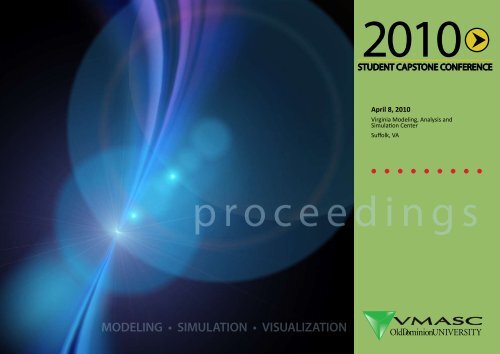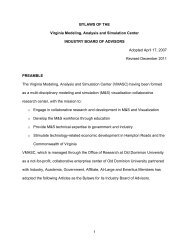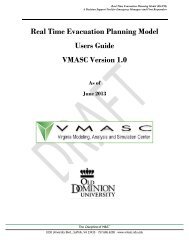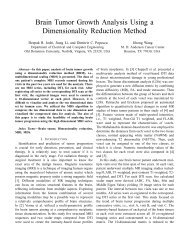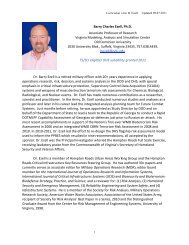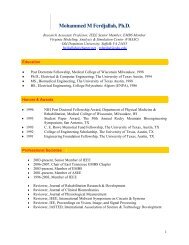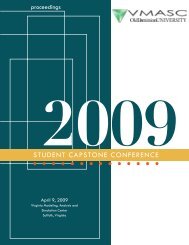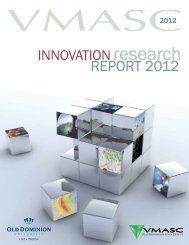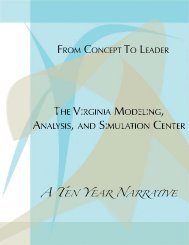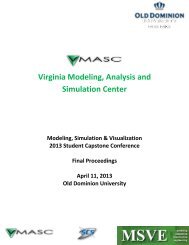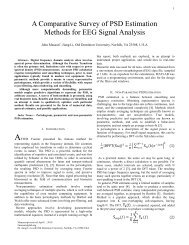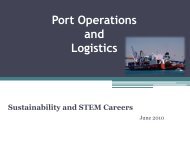2010 Student Capstone Proceedings (PDF) - the Virginia Modeling ...
2010 Student Capstone Proceedings (PDF) - the Virginia Modeling ...
2010 Student Capstone Proceedings (PDF) - the Virginia Modeling ...
Create successful ePaper yourself
Turn your PDF publications into a flip-book with our unique Google optimized e-Paper software.
April 8, <strong>2010</strong><br />
<strong>Virginia</strong> <strong>Modeling</strong>, Analysis and<br />
Simulation Center<br />
Suffolk, VA<br />
• • • • • • • • •<br />
proceedings<br />
MODELING • SIMULATION • VISUALIZATION
Edited by<br />
Kaleen J. Lawsure<br />
©<strong>2010</strong> ODU/VMASC MS&V<br />
<strong>Student</strong> <strong>Capstone</strong> Conference<br />
Responsibility for <strong>the</strong> accuracy of all statements in<br />
each paper rests solely with <strong>the</strong> author(s). Statements<br />
are not necessarily representative of, nor endorsed by<br />
<strong>the</strong> <strong>Virginia</strong> <strong>Modeling</strong>, Analysis and Simulation Center<br />
(VMASC). Permission is granted to photocopy portions<br />
of this proceeding for student use providing <strong>the</strong> source<br />
is cited giving credit to <strong>the</strong> <strong>2010</strong> VMASC MS&V <strong>Student</strong><br />
<strong>Capstone</strong> Conference. Permission is not granted to any<br />
o<strong>the</strong>r type of reproduction.<br />
The <strong>Virginia</strong> <strong>Modeling</strong>, Analysis and Simulation Center<br />
1030 University Boulevard • Suffolk, <strong>Virginia</strong> 23435<br />
Invited Keynote Speakers<br />
Dr. Agostino Bruzzone, University of Genoa<br />
Dr. Tuncer Ören, University of Ottawa<br />
Conference General Chairperson<br />
Kaleen Lawsure<br />
Primary Sponsor<br />
The <strong>Virginia</strong> <strong>Modeling</strong>, Analysis and<br />
Simulation Center<br />
http://www.vmasc.odu.edu/<br />
conferences/capstone<strong>2010</strong>.html
MODELING • SIMULATION • VISUALIZATION<br />
Table of Contents<br />
Overview • • • • • • • 2<br />
Keynote Speakers • • • • • • • 3<br />
Conference Tracks, Track Leaders & Judges • • • • • • • 4 - 5<br />
<strong>2010</strong> <strong>Student</strong> <strong>Capstone</strong> Winners • • • • • • • 7<br />
Conference Abstracts • • • • • • • 8 - 16<br />
Conference Attendees • • • • • • • 17<br />
Sponsors • • • • • • • 18 - 19
<strong>Modeling</strong>, Simulation, and Visualization<br />
An<br />
<strong>Student</strong><br />
Overview<br />
<strong>Capstone</strong> Conference<br />
The <strong>Virginia</strong> <strong>Modeling</strong>, Analysis, and Simulation Center is pleased to provide <strong>the</strong><br />
conference proceeding for <strong>the</strong> <strong>2010</strong> <strong>Modeling</strong>, Simulation & Visualization (MS&V)<br />
<strong>Student</strong> <strong>Capstone</strong> Conference.<br />
This annual conference featured students from <strong>the</strong> ODU <strong>Modeling</strong> and Simulation<br />
graduate degree program and o<strong>the</strong>r national and international colleges or<br />
universities. The student research and projects submitted to <strong>the</strong> conference are<br />
central to MS&V. It is here that students are given a venue to present <strong>the</strong>ir research<br />
to members of <strong>the</strong> modeling and simulation community in academe, industry, and<br />
government. For many of our students <strong>the</strong>se presentations serve as a culmination<br />
of <strong>the</strong>ir research and academic careers.<br />
The <strong>2010</strong> conference facilitated five tracks and each track was assigned judges who<br />
voted for <strong>the</strong> first, second, and third outstanding project of that particular track.<br />
These students were recognized at <strong>the</strong> <strong>Capstone</strong> Banquet <strong>the</strong> evening of April 8th.<br />
Also participating in <strong>the</strong> conference were faculty who have volunteered <strong>the</strong>ir time<br />
to impart direct support to <strong>the</strong>ir students’ research by facilitating <strong>the</strong> various<br />
conference tracks, serving as referees for papers, serving as judges for each of <strong>the</strong><br />
tracks, and providing overall assistance to this conference.<br />
2 • • • • • • • <strong>Capstone</strong> <strong>2010</strong>
KEYNOTE<br />
speakers<br />
MODELING • SIMULATION • VISUALIZATION<br />
Dr. Tuncer Ören | University of Ottawa, Canada<br />
Dr. Tuncer Ören is a Professor Emeritus of Computer<br />
Science at <strong>the</strong> School of Information Technology and<br />
Engineering of <strong>the</strong> University of Ottawa, Canada. His<br />
Ph.D. is in Systems Engineering from <strong>the</strong> University of<br />
Arizona.<br />
His research interests include advanced<br />
methodologies for modelling and simulation, agentdirected<br />
simulation, cognitive simulation, failure<br />
avoidance, and ethics in simulation as well as body of<br />
knowledge and terminology of simulation.<br />
He has over 400 publications including 21 books and proceedings. He<br />
contributed to over 370 conferences and seminars held in 30 countries.<br />
Some of <strong>the</strong> positions Dr. Ören currently has within SCS (The Society for<br />
<strong>Modeling</strong> and Simulation International) are: member of <strong>the</strong> Board of<br />
Directors, VP Publications, AVP ethics, AVP student chapters, distinguished<br />
lecturer, and founding director of M&SNet.<br />
Dr. Tuncer Ören’s awards include “Information Age Award” from <strong>the</strong> Turkish<br />
Ministry of Culture, and Distinguished Service Award from SCS. Honors<br />
and distinctions include recognition by IBM as a pioneer of computing in<br />
Canada, invitations from United Nations, over 20 Who’s Who citations, and<br />
plaques and certificates of appreciation from organizations including ACM,<br />
AFCEA, Atomic Energy of Canada, NATO, SCS, Turkish General Staff, and<br />
some universities.<br />
Dr. Agostino G. Bruzzone | University of Genoa, Italy<br />
Agostino G. Bruzzone began his engineering studies at <strong>the</strong> Italian Naval<br />
Academy with <strong>the</strong> Faculty of Pisa in 1984. After successfully completing<br />
this phase, he transferred to <strong>the</strong> University of Genoa where he earned his<br />
doctorate in Mechanical Engineering.<br />
Since 1991, he has taught “Theories and Techniques of Automatic Control”<br />
and in 1992 he has become a member of <strong>the</strong> industrial simulation work<br />
group at <strong>the</strong> ITIM University of Genoa. Dr. Bruzzone has extensively utilized<br />
simulation techniques in harbor terminals, maritime trading and sailboat<br />
racing sectors. He worked on research projects involving innovative<br />
modeling, AI techniques and DOE (Design of Experiments); particular<br />
attention was focused on <strong>the</strong> application of Neural Networks, GAs and Fuzzy Logic to industrial<br />
plant problems using Simulation and Chaos Theory.<br />
Dr. Bruzzone has been actively involved in <strong>the</strong> scientific community for several years and served<br />
as Director of <strong>the</strong> McLeod Institute of Simulation Science (MISS), Associate Vice-President and<br />
Member of <strong>the</strong> Board of <strong>the</strong> SCS (Society for Modelling & Simulation International), President<br />
of <strong>the</strong> Liophant Simulation, Vice President of MIMOS (Movimento Italiano di Simulazione), Vice<br />
Director of M&S Net, Industrial Relation Chair in SCS Europe, Italian Point of Contact for <strong>the</strong> ISAG<br />
(International Simulation Advisory Group) and Sim-Serv. In addition, Dr. Bruzzone has written<br />
more than 150 scientific papers as well as technical and professional reports in partnerships with<br />
major companies (i.e. IBM, Fiat Group, Contship, Solvay) and agencies (i.e. Italian Navy, NASA,<br />
National Center for Simulation, US Army).<br />
Dr. Bruzzone is presently Director of <strong>the</strong> Technical Council of “SIMulation applications in<br />
Management, PLanning & forEcaSTing” for <strong>the</strong> Society of Computer Simulation International. He<br />
is MISS DIPTEM Genoa Director for <strong>the</strong> McLeod Institute of Simulation Science (an Institution with<br />
over 28 Centers distributed worldwide: Brazil, China, USA, UK, Italy, France, Germany, Canada,<br />
Spain etc.). He is founder member and president of <strong>the</strong> Liophant Simulation. He is also a member<br />
of Who’s Who, IEEE, IASTED, ANIMP, SCS, MIMOS, etc.<br />
Agostino G. Bruzzone currently works in <strong>the</strong> Department of Industrial Production, Thermoenergy,<br />
Engineering and Ma<strong>the</strong>matical Modelling (DIPTEM) at <strong>the</strong> University of Genoa as a Full Professor.<br />
He is active in <strong>the</strong> field of simulator-based applications for industrial plants, developing new<br />
methodologies and intelligent system integration techniques. As director of <strong>the</strong> Master Program<br />
in Industrial Plants for Genoa University, his courses include Project Management and Industrial<br />
Logistics, Management Engineering, Logistics & Production Engineering, Modelling & Simulation,<br />
and M&S for Biomedical Systems.<br />
<strong>Capstone</strong> <strong>2010</strong> • • • • • • • 3
Presentation Tracks, Track Leaders, and Judges<br />
Conference Tracks<br />
General Science • • • • • • • • •<br />
Track Leader: Dr. Joshua Behr, VMASC<br />
1) Dr. Hua Liu, Old Dominion University<br />
2) Mr. Thomas Verna, Lockheed Martin<br />
This track encompasses <strong>the</strong> use of modeling and simulation in <strong>the</strong> nonmedical<br />
sciences and is open to all science disciplines. Examples include,<br />
but are not limited to, ecology, evolution, paleontology, climate modeling,<br />
oceanography, biochemistry and behavior. Any application of modeling and<br />
simulation in <strong>the</strong> life sciences is a candidate for this track.<br />
Homeland Security/Military • • • • • • • • •<br />
Track Leader: Dr. Barry Ezell, VMASC<br />
1) Dr. Steven Bennett, DHS Office of Risk Management and Analysis<br />
2) Mr. Richard Flannery, Hampton Roads Planning District Commission<br />
3) Dr. Jennie Jastrzembski, TRADOC Operations Analysis & Evaluations<br />
Division<br />
This track encompasses modeling and simulation that has been applied in<br />
ei<strong>the</strong>r <strong>the</strong> military or homeland security domain. It will also include any work<br />
done in <strong>the</strong>se domains that interfaces M&S capabilities with command and<br />
control systems and M&S work to support operations research, analysis, and<br />
visualization of military or homeland security systems or problems.<br />
Medical M&S • • • • • • • • •<br />
Track Leader: Dr. Gianluca DeLeo, VMASC/ODU College of Health Sciences<br />
1) Mr. Robert J. Alpino, Eastern <strong>Virginia</strong> Area Health Education Center<br />
2) Dr. Jeff Wilkinson, MYMIC<br />
This track looks into various aspects of medical modeling and simulation from<br />
imaging capability to <strong>the</strong> augmented standardized patient (using augmented virtual<br />
reality). <strong>Modeling</strong> of physical systems, such as joints and muscles, <strong>the</strong> virtual<br />
operating room, and virtual reality for rehabilitation are also key to this application<br />
area. The development of simulators and <strong>the</strong> validation of those simulators will also<br />
be covered in this track.<br />
4 • • • • • • • <strong>Capstone</strong> <strong>2010</strong>
MODELING • SIMULATION • VISUALIZATION<br />
M&S in Engineering • • • • • • • • •<br />
Track Leader: Dr. Rafael Diaz, VMASC<br />
1) Dr. Hüseyin Sarper, Colorado State University<br />
2) Mr. Jeff Laskowski, Lockheed Martin<br />
This track focuses on M&S methodologies and applications in <strong>the</strong> broader domain of<br />
engineering. One aspect is that simulation more and more replaces <strong>the</strong> traditional<br />
experimentation and prototyping. The track looks for such M&S ideas and examples and<br />
necessary changes in <strong>the</strong>se traditional disciplines. Examples are, but are not limited to,<br />
enterprise decision support, optimization, product design, testing, life cycle support, and<br />
more.<br />
Transportation • • • • • • • • •<br />
Track Leader: Mr. Mike Robinson, VMASC<br />
1) Ms. Amy Truesdell, Dewberry, Emergency Management & Homeland Security Branch<br />
2) Dr. Jeff Adler, Open Roads Consulting, Inc.<br />
This track includes applications of modeling and simulation to solving multimodal<br />
transportation problems. The development, validation, and application of microscopic and<br />
macroscopic traffic simulation, travel demand models, and hardware in <strong>the</strong> loop simulation<br />
are appropriate research topics for surface (road) transportation. Simulations of port<br />
facilities, railroads, and <strong>the</strong> air transportation system are also included in this track.<br />
• • • • • • • • •<br />
<strong>Capstone</strong> <strong>2010</strong> • • • • • • • 5
The Gene Newman Award for Excellence in M&S Research<br />
The Gene Newman Award for Excellence in M&S Research was established in recognition of Mr. Eugene G.<br />
Newman for his tireless effort in advancing modeling and simulation education, research, and development.<br />
Mr. Newman played a significant role in <strong>the</strong> creation of VMASC (in 1997) by realizing <strong>the</strong> need for credentialed<br />
experts in <strong>the</strong> M&S workforce in <strong>the</strong> military and in industry. His foresight has affected both <strong>the</strong> economic<br />
development and <strong>the</strong> high level of expertise in <strong>the</strong> M&S community of Hampton Roads.<br />
<strong>Student</strong>s receiving this first place award have proven <strong>the</strong>mselves to be outstanding researchers and practitioners<br />
of modeling and simulation.<br />
6 • • • • • • • <strong>Capstone</strong> <strong>2010</strong>
student<br />
WINNERS<br />
• • • • • • • • •<br />
Transportation<br />
1 st Ilyas Ustun, Old Dominion University<br />
2 nd Faisal Mahmud, Old Dominion University<br />
3 rd Prakash Viswanathan, Old Dominion<br />
University<br />
Medical M&S<br />
1 st Jacqueline Jackson, Old Dominion University<br />
2 nd Deepak R. Joshi, Old Dominion University<br />
3 rd Lydia Wigglesworth-Ballard, Old Dominion<br />
University<br />
Homeland Security/Military<br />
1 st Elaine Blount, Old Dominion University<br />
2 nd Jessica Jones, Old Dominion University<br />
3 rd Zachary Fenn, United States Military Academy<br />
M&S in Engineering<br />
General Science<br />
1 st Francesca Madeo, Federico Tarone, University<br />
of Genoa, Italy<br />
2 nd Marshall Gangel, Old Dominion University<br />
3 rd Mat<strong>the</strong>w McClary, Raymond Vetter, Joseph Van<br />
Dusen, Kurt Bujewski, United States Military<br />
Academy<br />
1 st Nick Drucker, Kenyth Campbell, Old Dominion<br />
University<br />
2 nd Narisong Huhe, Old Dominion University<br />
3 rd Suriyan Saramul, Old Dominion University<br />
<strong>Capstone</strong> <strong>2010</strong> • • • • • • • 7
abstracts<br />
Homeland Security/Military • • • • • • • • •<br />
<strong>Modeling</strong> Arms Races: The Necessity of an Interdisciplinary Approach<br />
Jessica A. Jones<br />
Abstract: The attention given to modeling arms races has dropped off in <strong>the</strong><br />
literature since <strong>the</strong> end of <strong>the</strong> Cold War, yet <strong>the</strong> research is critical. There are a<br />
number of modeling methods appropriate for use in investigating arms races that<br />
span across many disciplines including economics, international relations <strong>the</strong>ory,<br />
game <strong>the</strong>ory, and decision-making. I advocate a renewed interest in modeling arms<br />
races to update <strong>the</strong> research as well as generate policy recommendations to increase<br />
<strong>the</strong> preparedness of <strong>the</strong> US to effectively and efficiently manage future arms races.<br />
Models to date have had limited success in mapping arms races because of <strong>the</strong>ir<br />
limited focus. Many qualitative models lack <strong>the</strong> strategic interaction component of<br />
game <strong>the</strong>ory and, <strong>the</strong>refore, conclude with inconsistencies in <strong>the</strong>ir findings. A process<br />
of characterizing <strong>the</strong> conditions and constraints on various arms race scenarios will<br />
greatly improve <strong>the</strong> accuracy and efficiency of an interdisciplinary model. Integrating<br />
<strong>the</strong> risks associated with multiple nuclear false alarms into <strong>the</strong> model will fur<strong>the</strong>r<br />
aid in highlighting <strong>the</strong> risks associated with arms races especially in a world where<br />
a growing number of nations are expanding <strong>the</strong>ir military capabilities. The use of an<br />
interdisciplinary model for assessing potential future conflict will aid in developing<br />
preparation and policy options for US involvement. Action-oriented policy, as<br />
opposed to reaction-oriented policy, would expand <strong>the</strong> leverage of <strong>the</strong> US in diffusing<br />
dangerous scenarios before <strong>the</strong>y occur ra<strong>the</strong>r than after <strong>the</strong> fact. In a changing global<br />
political, economic, technological, and social environment preparedness is key in<br />
securing national security and global stability.<br />
Assessing Information Assurance Architectures for Protected Communications On<br />
The Move<br />
CDT Zachary Fenn, United States Military Academy<br />
Abstract: Troops in combat require up-to-date information to complete <strong>the</strong>ir mission<br />
successfully and with minimal loss. To facilitate this, <strong>the</strong> Department of Defense<br />
is sponsoring an acquisition program to develop a satellite terminal to provide<br />
commanders, as low as platoon level, access to <strong>the</strong> Warfighter Information Network<br />
– Tactical (WIN-T) and Global Information Grid (GIG). This project, known as Protected<br />
Communications On The Move (PCOTM), would improve our military’s situational<br />
awareness and increase our combat power. The National Security Agency (NSA)<br />
has been tasked to provide security guidance for <strong>the</strong> PCOTM information security<br />
architecture and our group has been tasked with helping <strong>the</strong> NSA assess and improve<br />
it. We are using <strong>the</strong> Systems Decision Process (SDP) developed by <strong>the</strong> Department<br />
• • • • • • • • •<br />
of Systems Engineering at <strong>the</strong> United States Military Academy to build a value model<br />
to evaluate <strong>the</strong> information assurance architecture. This model is being constructed<br />
based on research we have done through interviews with military commanders who<br />
have been deployed (<strong>the</strong> intended users), information assurance documents and<br />
professional knowledge , and technical knowledge about <strong>the</strong> hardware and software<br />
being used to design <strong>the</strong> terminal from <strong>the</strong> Lincoln Labs at <strong>the</strong> Massachusetts<br />
Institute of Technology. This model will allow us to compare different architectures<br />
and inform <strong>the</strong> NSA on <strong>the</strong> areas that PCOTM is not meeting <strong>the</strong>ir goals and where<br />
<strong>the</strong>y should focus <strong>the</strong>ir development efforts.<br />
The Incorporation of Layout Design into an Agent-based Evacuation Model<br />
Tariq M. Elhassani, Jun Zhang, Mahmoud T. Khasawneh, and Ra’ed M. Jaradat<br />
Abstract: The innovative designs and layouts of buildings and public places have<br />
created a major issue in evacuating a massive group of people under intense and<br />
panic situations. In this paper, we developed an agent-based model to investigate <strong>the</strong><br />
effect of layout design, people, and nature of threat on emergency evacuation. The<br />
purpose of this research was to provide a preliminary attempt at using agent-based<br />
modeling and simulation analysis to explore potential options that people have when<br />
faced with bomb explosion in an open market Environment. The results show that<br />
evacuation time, number of fatalities, and number of injuries are influenced by <strong>the</strong><br />
layout design components, namely locations of rescue area, check point, and <strong>the</strong><br />
bomb itself.<br />
Guns in Demand: <strong>Modeling</strong> <strong>the</strong> Arms Trade<br />
Cody Zimmerman<br />
Abstract: This NetLogo model is designed to, at a very basic level, simulate <strong>the</strong> trade<br />
in arms between states in <strong>the</strong> international system, as a foundation for fur<strong>the</strong>r<br />
expansions to include procedures that simulate <strong>the</strong> formation of alliances, strategic<br />
arms exporting, and war itself. At <strong>the</strong> basic level, <strong>the</strong> model succeeds, in that<br />
money and guns change hands between states, and it even captures at least one of<br />
<strong>the</strong> phenomena seen in <strong>the</strong> real world: spiraling, but stable, arms races. However,<br />
<strong>the</strong> model would benefit greatly from revision to certain procedures. Supply is<br />
determined solely by states as a function of <strong>the</strong>ir security, and client states buy what<br />
is offered whe<strong>the</strong>r <strong>the</strong>y “need” <strong>the</strong> quantity being sold or not, or whe<strong>the</strong>r it would<br />
bankrupt <strong>the</strong>m or not. Coding some form of fiscal responsibility would both temper<br />
<strong>the</strong> high bankruptcy rate seen in <strong>the</strong> first year or two of simulations, as well as<br />
endogenously create an element of demand to interact with <strong>the</strong> supply. Moreover, all<br />
8 • • • • • • • <strong>Capstone</strong> <strong>2010</strong>
MODELING • SIMULATION • VISUALIZATION<strong>2010</strong><br />
states can be producers under <strong>the</strong> right circumstances, and all states must buy arms<br />
from o<strong>the</strong>r states, instead of producing <strong>the</strong>m indigenously. Endowing states with a<br />
production capability, so that only a handful of states are able to make and sell arms,<br />
and so producer-states meet <strong>the</strong>ir own demand, would fur<strong>the</strong>r increase <strong>the</strong> accuracy<br />
of <strong>the</strong> model.<br />
employees, quantities of claims processed, and distributed processing times in order<br />
to accurately represent <strong>the</strong> current VBA system. With <strong>the</strong> help of our simulation<br />
software, and <strong>the</strong> VBA’s universal Claims Processing Initiative, our team’s effort has a<br />
high probability of creating a national impact on <strong>the</strong> way <strong>the</strong> Department of Veterans<br />
Affairs gives back to our nation’s military.<br />
Physical Fitness for Tactical Success<br />
Elaine M Blount<br />
Abstract: Tactical simulations assume that all participants have <strong>the</strong> same level of<br />
fitness and <strong>the</strong> same capabilities in all battlefield tests. This article discusses <strong>the</strong><br />
importance of including data from physical tasks performed on <strong>the</strong> battlefield and<br />
<strong>the</strong> importance of physical fitness to perform <strong>the</strong>se tasks successfully. It focuses<br />
on <strong>the</strong> 3-5 second rush and <strong>the</strong> rate of travel necessary for various chances of a<br />
successful rush given enemy shooter accuracy of 20% and cadence of one shot per<br />
.5 seconds. It continues to discuss potential shooter reaction time from visualization<br />
and human performance studies. The final simulation incorporates multiple rush<br />
scenarios based upon <strong>the</strong> width of streets in Lashkar Gah, Afghanistan.<br />
M&S in Engineering • • • • • • • • •<br />
West Point <strong>Capstone</strong> Project: Claims Processing Improvement of <strong>the</strong> Veterans<br />
Benefits Administration using Simulation<br />
Mat<strong>the</strong>w McClary, Raymond Vetter, Joseph Van Dusen, Kurt Bujewski<br />
Abstract: The Department of Veterans Affairs is currently experiencing a backlog<br />
of over 125,000 claims from military veterans seeking compensation for disabling<br />
medical conditions related to <strong>the</strong>ir military service. Claims are processed at 58<br />
regional Veterans Benefits Administration (VBA) offices throughout <strong>the</strong> United<br />
States. On average, <strong>the</strong> time to complete an individual claim exceeds <strong>the</strong> processing<br />
standard by over 36 days resulting in a wait of over five months before claimants<br />
receive <strong>the</strong>ir disability compensation; <strong>the</strong>refore, <strong>the</strong> Undersecretary of VBA has<br />
called upon our <strong>Capstone</strong> group to perform a systems engineering analysis of <strong>the</strong><br />
situation and provide potential solutions to <strong>the</strong>ir problem. In order to analyze <strong>the</strong><br />
current VBA system, our team uses a systems decision making process, coupled with<br />
ProModel simulation software, to quantitatively evaluate <strong>the</strong> process in its current<br />
form and compare <strong>the</strong>m with new models integrated with system improvements<br />
drawn from our research. Our research currently includes primary sources from <strong>the</strong><br />
Philadelphia VBA processing center, <strong>the</strong> office of <strong>the</strong> Undersecretary of VBA, and <strong>the</strong><br />
Military Operations Research Society. Our simulation encompasses <strong>the</strong> number of<br />
Environmental Impact Analysis in a Port Simulation<br />
Francesca Madeo, Federico Tarone, Agostino Bruzzone<br />
Abstract: In recent years, all countries had to cope <strong>the</strong> increasing awareness to <strong>the</strong><br />
environmental problems, referring to <strong>the</strong> concept of sustainable development of<br />
firms and society. This research deals with <strong>the</strong> environmental impact analysis in a<br />
port simulation in order to estimate <strong>the</strong> emission entities and evaluate improvements<br />
to increase <strong>the</strong> port sustainability; in fact <strong>the</strong> purpose is to reduce consumption,<br />
garbage/waste disposal, noise, Ship discharges and spills. In this paper <strong>the</strong> authors<br />
use a simulation model to estimate <strong>the</strong> environmental impacts and to outline<br />
different strategies to optimize <strong>the</strong> supply chain sustainability; In fact, analysis use<br />
GreenLog Simulator, a <strong>Modeling</strong> & Simulation tool developed by <strong>the</strong> authors to<br />
modelling and evaluate environmental impact in <strong>the</strong> every supply chain levels. The<br />
experimental application provides ano<strong>the</strong>r opportunity for validating and verifying<br />
<strong>the</strong> simulator.<br />
A Preliminary Framework for Analyzing Warehouse Picking Operation by Discrete<br />
Event Simulation<br />
Mandar Tulpule<br />
Abstract: Increasing importance of efficient and cost effective supply chains has led<br />
to critical thinking in various aspects of supply chain management. Warehousing is an<br />
important aspect of any supply chain as it provides <strong>the</strong> service of receiving, storage,<br />
sorting and distribution of products, which is critical to any enterprise. It also plays<br />
<strong>the</strong> key role of receiving bulk shipments of products from supplier and satisfying<br />
customer orders, which are usually smaller quantities of a large number of items.<br />
This naturally leads to an order picking activity in <strong>the</strong> warehouse, which is done<br />
manually; in a number of warehouses and hence presents a significant cost. In this<br />
paper, we attempt to prepare groundwork for future research by surveying relevant<br />
literature pertaining to order picking and gain an understanding of <strong>the</strong> key issues<br />
and approaches used by previous researchers. We particularly focus on warehouse<br />
zoning and storage location assignment. We <strong>the</strong>n build, a simulation model and<br />
perform a set of experiments to compare two popular storage location assignment<br />
<strong>Capstone</strong> <strong>2010</strong> • • • • • • • 9
abstracts<br />
• • • • • • • • •<br />
policies namely cube per index and random location. We use <strong>the</strong>se experiments to<br />
test and validate <strong>the</strong> model by comparing results of similar study in <strong>the</strong> literature. We<br />
conclude by discussing our results and proposing future direction for extending this<br />
research.<br />
Exploring <strong>the</strong> Contagion Effect of Foreclosures with Agent-Based <strong>Modeling</strong><br />
Marshall Gangel<br />
Abstract: Over <strong>the</strong> last several years, <strong>the</strong> US financial and real estate markets have<br />
experienced a significant recession. During this downturn, <strong>the</strong> number of real estate<br />
foreclosures rose drastically. Recent studies have shown reduction in real estate<br />
values due to neighboring foreclosures. This study uses an Agent-based modeling<br />
(ABM) approach to explore <strong>the</strong> contagion effect of foreclosures and <strong>the</strong> emergent<br />
behavior that is observed from <strong>the</strong> interconnected property agent behavior. Several<br />
emergent behaviors are exposed showing <strong>the</strong> relationships between average<br />
property value, foreclosure contagion discount, and foreclosure time.<br />
<strong>Modeling</strong> & Simulation - A System of Systems Engineering View<br />
Polinpapilinho F. Katina<br />
Abstract: The purpose of this paper is to explore <strong>the</strong> value of modeling and<br />
simulation as related to system of systems (SoS) engineering using Discrete Event<br />
Simulation Formalism. The paper traces <strong>the</strong> importance of Independent Verification<br />
and Validation (IV &V) and also explores <strong>the</strong> use of sociotechnical system principles<br />
and how <strong>the</strong>y can be related to system of systems Engineering (SoSE). An example<br />
is provided to illustrate <strong>the</strong> use of Discrete Event System Specification (DEVS) and of<br />
<strong>the</strong> possibilities for advancement of SoS in terms of philosophies, methodologies, and<br />
<strong>the</strong>ories related to modeling and simulation.<br />
techniques to both <strong>the</strong> real world video image and <strong>the</strong> rendered virtual object. The<br />
inherent requirement of real-time operation of AR is satisfied by implementing <strong>the</strong><br />
mentioned techniques on GPU by using NVIDIA’s CUDA.<br />
General Science • • • • • • • • •<br />
Development of Circulation Model for <strong>the</strong> Upper Gulf of Thailand (UGoT)<br />
Suriyan Saramul<br />
Abstract: The pollution problems, such as eutrophication, in <strong>the</strong> Upper Gulf of<br />
Thailand is mainly influenced by human activities. The knowledge of <strong>the</strong> circulation<br />
pattern in <strong>the</strong> Upper Gulf will help us to understand <strong>the</strong> behavior of pollutant after<br />
being release into <strong>the</strong> system and finally <strong>the</strong> management could be applied in order<br />
to solve those problems. Therefore, <strong>the</strong> circulation modeling for <strong>the</strong> Upper Gulf<br />
has to be considered as a tool to understand <strong>the</strong> circulation pattern. The twodimensional<br />
depth-averaged model (2DH) of <strong>the</strong> Delft3D-Flow modeling system<br />
developed by Delft Hydraulics was applied to compute tides and tidal currents in <strong>the</strong><br />
Upper Gulf. The finite-differencing was schematized on <strong>the</strong> curvilinear grid system.<br />
At <strong>the</strong> open sea boundary, a total of 8 tidal constituents (M2, S2, N2, K2, O1, Q1, P1,<br />
and K1) were defined according to <strong>the</strong> observation data at two tide gauge stations.<br />
Comparisons between computed and observed water levels were made among <strong>the</strong><br />
tide guage stations that located along <strong>the</strong> coast. Fur<strong>the</strong>rmore comparisons between<br />
computed and observed current velocities at two Oceanographic Buoy stations were<br />
also taken into consideration. It was found that <strong>the</strong> model results show satisfactory<br />
agreement with <strong>the</strong> observation data for both water levels and current velocities and<br />
could be used to study for fur<strong>the</strong>r study. However discrepancies occurred during high<br />
water levels were found at some locations. These errors were investigated and finally<br />
it was found that land subsidence is <strong>the</strong> major reason for <strong>the</strong> changing of water levels<br />
at those two stations.<br />
GPU Accelerated Stylistic Augmented Reality<br />
Rifat Aras<br />
Abstract: With <strong>the</strong> introduction of programmable graphics pipeline, <strong>the</strong> highly<br />
parallel processing power of graphical processing units (GPU) is being used not only<br />
for special graphics effects but also for general purpose computation in areas such<br />
as molecular dynamics simulation, stock options pricing, and image processing. In<br />
this work, we utilize this power to increase <strong>the</strong> immersion level in an augmented<br />
reality (AR) application. To accomplish this task, <strong>the</strong> visual gap between real world<br />
and virtual objects are closed by applying non-photorealistic filtering/rendering<br />
A software tool for visualization of <strong>the</strong> cardiac action potential in a 2-dimensional<br />
tissue<br />
Prakash C. Viswanathan<br />
Abstract: Heart disease is <strong>the</strong> leading cause of death and disability in <strong>the</strong> United<br />
States. Several ma<strong>the</strong>matical models have been developed to simulate <strong>the</strong> electrical<br />
behavior of <strong>the</strong> heart. Models are used in several configurations (single cell or<br />
multi-cellular) depending upon <strong>the</strong> study and desired level of complexity. A major<br />
challenge with multi-dimensional models is <strong>the</strong> visualization of <strong>the</strong> generated data<br />
especially in real time. The goal of this study is to develop a software tool using<br />
10 • • • • • • • <strong>Capstone</strong> <strong>2010</strong>
MODELING • SIMULATION • VISUALIZATION<strong>2010</strong><br />
OpenGL (a software interface to <strong>the</strong> graphics hardware) routines to allow for easy<br />
visualization of <strong>the</strong> generated data in a multi-cellular tissue “grid”. To achieve this,<br />
<strong>the</strong> ma<strong>the</strong>matical model of <strong>the</strong> heart’s electrical activity is combined with OpenGL<br />
routines using C++ programming language. In addition to visualization of <strong>the</strong> data,<br />
<strong>the</strong> tool offers o<strong>the</strong>r features such as real time manipulation of key cellular proteins<br />
in order to investigate <strong>the</strong>ir role in modulating behavior. The tool was subsequently<br />
used to create and visualize “spiral waves” that have been thought to underlie several<br />
forms of cardiac arrhythmias. In conclusion, we have developed a software tool that<br />
can be used by researchers to study cardiac arrhythmias by easily visualizing <strong>the</strong><br />
electrical behavior in a multi-dimensional tissue.<br />
Differentiating between Serious Games and Computer Aided Instruction<br />
Michael Martin<br />
Abstract: As <strong>the</strong> field of Serious Games matures, it will become necessary to develop<br />
more precise definitions and understandings of what <strong>the</strong> term ‘serious game’<br />
means. This paper presents a discussion of one particular defining feature of a game,<br />
specifically, <strong>the</strong> ability of <strong>the</strong> user to choose from an array of viable alternatives.<br />
This distinction is useful for differentiating between games and o<strong>the</strong>r forms of<br />
computer based teaching. It is also important because it takes advantage of <strong>the</strong><br />
educational principle referred to as <strong>the</strong> psychosocial moratorium to enhance <strong>the</strong><br />
education potential of <strong>the</strong> software. This discussion is presented in <strong>the</strong> context of <strong>the</strong><br />
development of a serious game for teaching memorization of <strong>the</strong> periodic table of<br />
elements.<br />
An Analysis of <strong>the</strong> Value of Animated Pedagogical Agents in Instructional<br />
Simulations<br />
Jo Ann Reber-Thomas<br />
Abstract: This paper examines <strong>the</strong> many design aspects of animated pedagogical<br />
agents that may contribute to cognitive, affective, and behavioral learner effects<br />
through exploration of research that places emphasis on <strong>the</strong>ir added value to <strong>the</strong><br />
electronic learning environment.<br />
Designing physical instructional simulations to promote learning from multiple<br />
external representations<br />
Jennifer R. Morrison<br />
Abstract: This article provides a review of <strong>the</strong> conceptualization of imagery and its<br />
role in <strong>the</strong> learning environment. Multiple representations are <strong>the</strong> presentation of<br />
multiple images to <strong>the</strong> learner, which facilitate deeper understanding of content<br />
and can potentially increase <strong>the</strong> learners’ ability to transfer knowledge to additional<br />
situations. While <strong>the</strong> use of images in instruction is encouraged, few concrete design<br />
strategies exist for <strong>the</strong> use of multiple representations in instruction and even fewer<br />
exist for <strong>the</strong> design of instructional simulations where <strong>the</strong>se representations are<br />
thought to facilitate cognition of complex concepts. The role of images in learning,<br />
<strong>the</strong> manipulation of mental representations by experts in problem solving, and <strong>the</strong><br />
use of multiple representations are considered here in order to inform <strong>the</strong> design of<br />
physical instructional simulations.<br />
Dynamic and Static Training for Driving Simulation Route Performance<br />
Kellie D. Kennedy<br />
Abstract: The current research is a portion of a larger study dealing with reliability<br />
and GPS navigation. This section focuses on <strong>the</strong> participant performance resulting<br />
from static and dynamic route training in a simulated driving task. Performance<br />
measures include task success rating, average speed, overall duration of travel, and<br />
total distance traveled. Participants were divided into three navigational training<br />
groups: no training (control), static, and dynamic. Findings indicated that though<br />
both training groups acquired knowledge, <strong>the</strong> dynamic group achieved greater task<br />
success. All groups receiving training demonstrated task learning across sessions.<br />
These results suggest drivers may benefit from pre-exposure to navigational tasks<br />
and directives. Data cleaning resulted in a large floor effect in task performance with<br />
29 of 65 participants not completing <strong>the</strong> task appropriately. No significance was<br />
found in any training condition.<br />
An investigation of <strong>the</strong> dual-process <strong>the</strong>ory of decision making in simulated airport<br />
luggage screening<br />
Patricia C. Brennan<br />
Abstract: Enhancing <strong>the</strong> effectiveness of aviation security is vital to protect our<br />
national interests, passengers and aircraft. The purpose of this paper was to evaluate<br />
<strong>the</strong> dual-process model to determine whe<strong>the</strong>r emotion or cognition is more powerful<br />
in influencing decisions and behavior in threat detection. Using a 3 (frame: analytical,<br />
affective, comparative) x 2 (incentive: positive, negative) x 4 (trial block) design, we<br />
measured performance with hit rate, false alarm rate and response time. Our results<br />
indicate that <strong>the</strong> analytical frame outperformed both <strong>the</strong> affective and comparative<br />
frames. The analytical frame elicited rational thinking (gaining/losing points), <strong>the</strong><br />
affective frame elicited emotion (saving/losing lives) and <strong>the</strong> comparative frame<br />
elicited both rationality and emotion (performing better/worse than peers). By<br />
eliciting strong emotions, our reason and logic are inhibited and participants do not<br />
perform as well in target detection.<br />
<strong>Capstone</strong> <strong>2010</strong> • • • • • • • 11
abstracts<br />
• • • • • • • • •<br />
Emotion in Animated Pedagogical Agents Performing as Virtual Social Actors<br />
Enilda Romero<br />
Abstract: The use of pedagogical agents in instructional interactive environments<br />
allows learners to obtain one-on-one interaction with a virtual social actor creating<br />
<strong>the</strong> illusion of a human to human interaction. Today, <strong>the</strong> characteristics of <strong>the</strong>se<br />
pedagogical agents have transcended into far more animated characters that portray<br />
life-like qualities. Yet, learners still perceive <strong>the</strong>se animated pedagogical agents as<br />
characters with low level believability. A breakthrough in <strong>the</strong> application of character<br />
building qualities to increase <strong>the</strong> perceived believability of <strong>the</strong> agents could have<br />
positive effects towards increased levels of performance, engagement and sense<br />
of realism. The purpose of this paper is to present a strategy that could assist in <strong>the</strong><br />
design and development of emotionally expressive animated pedagogical agents<br />
performing as virtual social actors in interactive instructional environments. In an<br />
effort to provide a solution to increase <strong>the</strong> level of perceived believability of <strong>the</strong><br />
agents, an intellectual framework on <strong>the</strong> role of emotion in pedagogical agents is<br />
discussed. Facial expressions are presented as a solution to provide a more realistic<br />
emotional social interaction between <strong>the</strong> learner and a believable virtual social<br />
actor. Additionally, reference to <strong>the</strong> use of a Face Reader© software is addressed<br />
as a possible alternative to emotionally adaptive pedagogical agents. Suggestions<br />
are made for future empirical validation of both <strong>the</strong> role of emotion in pedagogical<br />
agents performing as virtual social actors and <strong>the</strong> use of <strong>the</strong> Face Reader© software<br />
in instructional interactive environments.<br />
The Future of Japan’s Population: An Agent Based <strong>Modeling</strong> Approach<br />
Erika Frydenlund<br />
Abstract: With a growing percentage of retirees and fertility rates at unsustainable<br />
levels, Japan is currently facing a population crisis. This model explores <strong>the</strong><br />
relationship between certain policy and cultural choices and <strong>the</strong> declining fertility<br />
rates in Japan. Government assistance allocated to each child and costs of living<br />
are explored as economic options to influence fertility rates. The effects of several<br />
cultural aspects are also explored including women’s desire to marry, percentage<br />
of women working while raising children, and parents’ level of cautiousness when<br />
determining whe<strong>the</strong>r to have additional children. Because <strong>the</strong> model consistently<br />
results in <strong>the</strong> extinction of <strong>the</strong> Japanese population, <strong>the</strong> factors are explored with<br />
respect to increasing <strong>the</strong> longevity of <strong>the</strong> population using survival analysis. Cost<br />
of living is, as expected, a very important factor in <strong>the</strong> model for both its individual<br />
contributions as well as its interaction with o<strong>the</strong>r factors. The results of this study<br />
interestingly indicate that government subsidies are not a significant factor in<br />
motivating couples to have more children.<br />
An Agent Based <strong>Modeling</strong> Approach to Examining <strong>the</strong> Relationships Between<br />
Education, Social Networks and Democratic Support<br />
Nick Drucker, Kenyth Campbell<br />
Abstract: This paper presents an agent-based model that explores <strong>the</strong> relationships<br />
between education, social networks, and democratic support. The debate about how<br />
and why democracies arise is a long running one, lacking a consensus answer. This<br />
study examines two factors that impact democratic support, education and social<br />
networks. Current <strong>the</strong>ory concerning <strong>the</strong>se two variables suggests that positive<br />
relationships exist between education and democratic support and social networks<br />
and <strong>the</strong> spread of ideas. The model described in this paper contains variables that<br />
cover multiple aspects of democratic support, but <strong>the</strong> experimentation with <strong>the</strong><br />
model focuses only on <strong>the</strong> two variables previously mentioned. The model in this<br />
paper is an agent-based model, allowing individual entities within <strong>the</strong> system to make<br />
“decisions” on <strong>the</strong>ir support of democracy independent of one ano<strong>the</strong>r. The agentbased<br />
approach also allows entities to utilize <strong>the</strong>ir social networks to spread ideas.<br />
Experimentation with this model demonstrated outcomes in line with current <strong>the</strong>ory.<br />
In addition, <strong>the</strong> results support <strong>the</strong> claim that this model is capable of accurately<br />
representing real world scenarios and does not produce un-realistic results.<br />
This paper explains <strong>the</strong> model creation process as well as <strong>the</strong> experimentation<br />
procedures. Future research avenues and potential shortcomings of <strong>the</strong> model are<br />
also addressed.<br />
Social Capital, Public Goods Provisions, and Economic Inequality: An Agent-Based<br />
<strong>Modeling</strong> Approach<br />
Narisong Huhe<br />
Abstract: How does social capital promote <strong>the</strong> provisions of public goods? Although<br />
myriads of quantitative researches offered us with insightful observations, <strong>the</strong>y failed<br />
to address <strong>the</strong> causal linkages connecting social capital and public goods provisions.<br />
To explore its micro causal mechanisms, this article uses an agent-based model<br />
to explore how social capitals promote or inhibit <strong>the</strong> provisions of public goods.<br />
Compared to traditional research methods, agent-based modeling allows researchers<br />
to explore <strong>the</strong> emergence phenomena under complex adaptive system (CAS).<br />
Specifically, by simulating social agents as generalized and particularized trusters, this<br />
research conducts 12, 960 runs of experimentation of emergences and functions of<br />
social capital under various scenarios. The results from experimentation generally<br />
confirm <strong>the</strong> beneficial impacts of generalized social capital. Systems with high level<br />
of generalized social capital are more abundant with public goods. Ra<strong>the</strong>r than solely<br />
focusing <strong>the</strong> consequences of social capital, this research also finds that economic<br />
inequality is a key determinant of creation social capital.<br />
12 • • • • • • • <strong>Capstone</strong> <strong>2010</strong>
MODELING • SIMULATION • VISUALIZATION<strong>2010</strong><br />
Medical M&S • • • • • • • • •<br />
Using <strong>Modeling</strong> and Simulation to Improve Oral Health Services Delivery<br />
Mohammad J. Alzahrani<br />
Abstract: The purpose of this study is to examine <strong>the</strong> system performance in<br />
delivering oral health services in a public health setting based on <strong>the</strong> Conceptual<br />
Framework to Measure Performance of <strong>the</strong> Public Health System (PHS). Using<br />
modeling and simulation, a predictive model based on <strong>the</strong> conceptual framework<br />
dimensions: macro context, mission, structural capacity, processes, and outcomes<br />
will be developed to predict <strong>the</strong> performance of public health department in<br />
delivering oral health services. <strong>Modeling</strong> and simulation (M&S) will enable <strong>the</strong><br />
author to modify <strong>the</strong> changeable variables without impacting <strong>the</strong> quality of care. In<br />
addition, using modeling and simulation methodology will enable dental practices<br />
to serve <strong>the</strong>ir clients effectively and efficiently with <strong>the</strong> best use of <strong>the</strong> resources.<br />
This research is going to address issues that affect <strong>the</strong> delivery of oral health<br />
care in public dental health settings. The results of this study will determine what<br />
variables in <strong>the</strong> dental practice setting influence oral health care delivery and to<br />
what extent. Results of this study will narrow <strong>the</strong> knowledge gap among oral health<br />
providers regarding <strong>the</strong> importance of modeling and simulation technique leading<br />
to improve oral health care delivery. This study will be <strong>the</strong> first to use M&S to<br />
examine PHS performance to deliver oral health services in public health settings.<br />
Many dental practices productions are complicated combination of parameters<br />
such as: information resources, organizational resources, physical resources,<br />
human resources and fiscal resources. Therefore, using simulation would be <strong>the</strong><br />
best approach when <strong>the</strong> system under investigation produces outcomes that are<br />
complicated, stochastic, and dynamic. Therefore, <strong>the</strong>se non-linear interactions make<br />
simulation modeling an appropriate methodology to study and improve <strong>the</strong> delivery<br />
of oral healthcare services outcomes in <strong>the</strong> public health settings. In addition, using<br />
modeling and simulation is less expensive than conducting research with many<br />
different parameters. This study will answer <strong>the</strong> following questions: are public<br />
health system conceptual framework dimensions: macro context, mission, structural<br />
capacity, processes, and outcomes appropriate to evaluate <strong>the</strong> oral health services<br />
performance in public health settings? What dimensions in <strong>the</strong> conceptual framework<br />
influence oral health care delivery and to what extent? Can using modeling and<br />
simulation improve <strong>the</strong> performance of public health settings in <strong>the</strong> delivery of oral<br />
healthcare? Index Terms— oral healthcare delivery, public health performance,<br />
modeling and simulation, public health settings.<br />
Use of polyethylene microspheres to simulate hospital acquired infections: a<br />
teaching strategy for healthcare students and workers<br />
Lydia Wigglesworth-Ballard<br />
Abstract: Hospital acquired infections are still a major problem in <strong>the</strong> United States<br />
despite infection control measures that have been put in place. The bacteria that<br />
cause most hospital acquired infections are constantly mutating and are becoming<br />
increasingly difficult to treat due to antibiotic resistance. This has created challenges<br />
for many hospitals and o<strong>the</strong>r clinical settings and many insurance companies will<br />
no longer cover <strong>the</strong> cost for <strong>the</strong>se types of infections. The guidelines that have<br />
been put in place by <strong>the</strong> Center for Disease Control and Prevention says that hand<br />
washing is <strong>the</strong> most important method in <strong>the</strong> fight against <strong>the</strong> spread of infections.<br />
However, hand washing compliance and techniques still fall short of <strong>the</strong>se guidelines.<br />
Ultraviolet polyethylene microspheres were developed and tested to determine if its<br />
behavior was sufficient to simulate <strong>the</strong> spread of hospital acquired infections and to<br />
determine if <strong>the</strong> microspheres could be used as a teaching strategy to incorporate<br />
into <strong>the</strong> curriculum for healthcare education and for infection control training in<br />
hospitals and clinical settings. The microspheres were able to simulate <strong>the</strong> spread of<br />
bacteria through direct and indirect contact on different surfaces and had <strong>the</strong> ability<br />
to be washed off under specific hand washing guidelines. Due to <strong>the</strong> positive results<br />
<strong>the</strong> use of microspheres as a simulator during instruction should be explored fur<strong>the</strong>r<br />
in order to improve hand washing techniques and compliance.<br />
An Analysis of Biosurveillance and Potential threats to Public Health<br />
Koren S. Goodman<br />
Abstract: The recent swine flu outbreak was a public health call to action to enhance<br />
established systems using electronically reported data to monitor real time utilization<br />
patterns. Public health organizations have invested in biosurveillance tools because<br />
of heightened threats of bioterrorism and emerging infectious diseases such as<br />
influenza. It has been made a priority in health care because of its ability to monitor<br />
information sources of potential value in detecting an emerging epidemic that occurs<br />
naturally or as <strong>the</strong> result of bioterrorism. One avenue of early detection of disease<br />
clusters to minimize morbidity and mortality is syndromic surveillance. Syndromic<br />
surveillance is defined as an avenue for early detection of disease clusters to<br />
minimize morbidity and mortality. With <strong>the</strong> shift of syndromic surveillance focusing<br />
now on bioterrorism, efforts are placed on proper collection, analysis, and reporting<br />
mechanisms. While <strong>the</strong>se mechanisms enhances disease detection, physicians will<br />
continue to play integral roles in reporting unusual occurrences. Understanding <strong>the</strong><br />
<strong>Capstone</strong> <strong>2010</strong> • • • • • • • 13
abstracts<br />
• • • • • • • • •<br />
epidemiology of infectious diseases in <strong>the</strong> United States involves <strong>the</strong> understanding<br />
of demographic, environmental, and geographic patterns. Because multiple data<br />
sources are used in this integrated system, global public health will be enhanced.<br />
Simulated events allow public health officials to formulate intervention strategies.<br />
Ultimately, <strong>the</strong> goal is to minimize time to detection and to have <strong>the</strong> ability to identify<br />
anomalies. This paper will explore <strong>the</strong> extent to which biosurveillance techniques are<br />
effective in identifying influenza outbreaks.<br />
A Comparative Survey of PSD Estimation Methods for EEG Signal Analysis<br />
John Musson<br />
Abstract: Digital frequency domain analysis often involves spectral power<br />
determination. Although <strong>the</strong> Fourier Transform is often <strong>the</strong> primary tool, limitations<br />
exist with respect to power spectral density (PSD) measurements. Accurate<br />
PSD calculation requires interpolation and smoothing techniques, prior to most<br />
applications typically found in modern test equipment. Non-parametric methods<br />
provide a means to create representative periodograms, which provide a variety of<br />
flexibility with respect to pre-filtering, data windowing, and smoothing. Although<br />
more computationally demanding, parametric models employ predictive algorithms<br />
to represent <strong>the</strong> PSD, to arbitrary accuracy. A survey of both methods is presented,<br />
using real biometric data. Benefits and shortcomings are identified, and an attempt is<br />
made to qualitatively optimize each particular method. Results are presented in <strong>the</strong><br />
form of numerical data, spectral estimates, and possible applications.<br />
Brain Tumor Growth Analysis Using a Dimensionality Reduction Method<br />
Deepak R. Joshi<br />
Abstract: In this paper, analysis of brain tumor growth using a dimensionality<br />
reduction method (DRM), i.e., multidimensional scaling (MDS) is presented. The data<br />
of one patient’s complete MRI records scanned during his visits in <strong>the</strong> past two years<br />
are used for <strong>the</strong> analysis. There are ten MRI series, including DTI, for each visit. After<br />
registering all series to <strong>the</strong> corresponding DTI scan at <strong>the</strong> first visit, <strong>the</strong> registered<br />
images were used to construct a 10-dimensional vector at each pixel. However, it<br />
is difficult to visualize and analyze <strong>the</strong> ten dimensional data set by human eyes. We<br />
utilized <strong>the</strong> MDS algorithm to compress <strong>the</strong> ten dimensional data to one dimension<br />
and visualized <strong>the</strong> compressed data for analysis. The aim of this paper is to study<br />
<strong>the</strong> feasibility of analysing brain tumor progression using <strong>the</strong> high dimensional MRI<br />
series.<br />
Games for Team Training<br />
Elena Radici<br />
Abstract: Team building has become an important organization development<br />
interventions widely used to train individual who has to work toge<strong>the</strong>r. In this paper<br />
we propose a team training through virtual reality for two related purpose: <strong>the</strong> first<br />
is to verify if it is possible a “team-building” by using <strong>the</strong> virtual world as a training;<br />
<strong>the</strong> second purpose is to test if a virtual training is useful for a team to perform better<br />
in a real environment. To verify this assumption we have trained college students<br />
to accomplish a serious game as a team using an on-line virtual environment as a<br />
training. Every team had to complete a task through his/her avatar to learn how to<br />
achieve <strong>the</strong> same task in a real environment after <strong>the</strong> training. The results so far are<br />
about <strong>the</strong> experiment in <strong>the</strong> real environment. Preliminary results show that <strong>the</strong>re<br />
are o<strong>the</strong>r fur<strong>the</strong>r areas about team building to investigate.<br />
The use of Getis and Ord cluster analysis for analyzing rainfall data in relation to<br />
Rift Valley fever outbreaks<br />
Jacqueline Jackson<br />
Abstract: Rift Valley fever (RVF) activity has been known to follow periods of high<br />
rainfall due to an increase in mosquito vectors following <strong>the</strong>se periods. Studies<br />
in Kenya and nor<strong>the</strong>rn Senegal have correlated RVF outbreaks with periods of<br />
widespread and heavy rainfall. Cluster analysis has been used to study geographic<br />
variation patterns such as rainfall but Getis and Ord spatial cluster analysis technique<br />
has not been used in <strong>the</strong> study of rainfall patterns. In order to determine <strong>the</strong><br />
usefulness of Getis and Ord cluster analysis in analyzing rainfall pattern analysis was<br />
performed on rainfall datasets prior to and during <strong>the</strong> 2006-2007 RVF outbreaks in<br />
Kenya and results compared to basic Geographic Information Systems (GIS) analysis<br />
results. Although basic GIS analysis found above average rainfall for December of<br />
2006 at <strong>the</strong> beginning of <strong>the</strong> RVF outbreak in Kenya, Getis and Ord spatial cluster<br />
analysis did not find such a relationship. Getis and Ord results were inconsistent and<br />
did not prove to be an effective way to analyze rainfall.<br />
14 • • • • • • • <strong>Capstone</strong> <strong>2010</strong>
MODELING • SIMULATION • VISUALIZATION<strong>2010</strong><br />
Transportation • • • • • • • • •<br />
Development and Validation of Peak Hour Model Using NCHRP Factors for <strong>the</strong><br />
Hampton Roads<br />
Peter Foytik<br />
Abstract: Macroscopic modeling and simulation does a good job at reflecting<br />
congestion of daily volume over daily capacity, but does not represent surges of<br />
vehicles and <strong>the</strong> directional congestion that could be useful. A peak hour model<br />
would act <strong>the</strong> same as <strong>the</strong> daily travel demand forecasting model (TDF) but only<br />
produce results for a peak hour by giving a clear representation of <strong>the</strong> directional<br />
level of service for each road segment within <strong>the</strong> network. This paper describes<br />
a method of creating a peak hour model using <strong>the</strong> National Cooperative Highway<br />
Research Program NCHRP 365 peak hour factors on production and attraction trips<br />
matrices. Next it will outline <strong>the</strong> method by modifying <strong>the</strong> Hampton Roads Traffic<br />
assignment to accommodate hourly assignment. Third it will provide values from a<br />
means of validation.<br />
Using discrete event simulation to identify choke points in passenger flow through<br />
airport checkpoints<br />
Jeremy Brown<br />
Abstract: The movement of passengers through an airport quickly, safely, and<br />
efficiently is <strong>the</strong> main function of <strong>the</strong> various checkpoints (check-in, security, etc)<br />
found in airports. Human error combined with o<strong>the</strong>r breakdowns in <strong>the</strong> complex<br />
system of <strong>the</strong> airport can disrupt passenger flow through <strong>the</strong> airport leading to<br />
lengthy waiting times, missing luggage and missed flights. In this paper we present a<br />
model of passenger flow through an airport using discrete event simulation that will<br />
provide a closer look into <strong>the</strong> possible reasons for breakdowns and <strong>the</strong>ir implications<br />
for passenger flow. The simulation is based on data collected at Norfolk International<br />
Airport (ORF). The primary goal of this simulation is to present ways to optimize <strong>the</strong><br />
work force to keep passenger flow smooth even during peak travel times and for<br />
emergency preparedness at ORF in case of adverse events.<br />
Origin Destination Estimation for Trucks Based on Re-identification Methods<br />
Ilyas Ustun<br />
Abstract: Origin-destination (OD) flows are important for transportation planning and<br />
modeling. The main objective of this paper is to estimate OD flows for trucks based<br />
on re-identification algorithms. Trucks crossing two weigh-in-motion (WIM) sites<br />
are anonymously re-identified based on axle spacing and axle weight data. The sites<br />
selected for this study are separated by more than 100 miles. The data for model<br />
training and testing is obtained from WIM sites in Oregon. Two different OD pairs<br />
or links are considered in this study. Several methods are evaluated for estimating<br />
OD flows. The parameters or threshold values of <strong>the</strong>se methods are first optimized<br />
based on <strong>the</strong> known OD flows on one of <strong>the</strong> links. When <strong>the</strong> optimized thresholds<br />
are applied to <strong>the</strong> o<strong>the</strong>r link, <strong>the</strong> estimated flows are found to be very close to <strong>the</strong><br />
actual flows, within 3-10%, which show that <strong>the</strong> proposed methods can be effective<br />
in estimating truck-flows between WIM sites.<br />
Transit Signal Priority Assessment for LRT in Downtown Norfolk: Transit Preference<br />
Traffic Impacts<br />
Faisal Mahmud<br />
Abstract: Transit Signal Priority (TSP) is an operational strategy that facilitates<br />
<strong>the</strong> movement of transit vehicles like buses, LRT (Light Rail Transit) or streetcars,<br />
through traffic-signal controlled intersections. The benefits of TSP include improved<br />
schedule adherence and improved transit travel time efficiency while minimizing<br />
impacts to normal traffic operations. New advances in Global Positioning Systems,<br />
detection and communication, and control strategies have overcome many problems<br />
with early systems and increased interest in implementing TSP for LRT and o<strong>the</strong>r<br />
transit operations. The increased capabilities of <strong>the</strong>se advanced systems have led<br />
to a dramatic increase in operational and planned TSP deployments across <strong>the</strong> U.S.<br />
This study will show <strong>the</strong> at grade ( or street level) Tide light rail (LRT in Norfolk, VA)<br />
operational impacts which will extend 7.4 miles on an east to west alignment from<br />
<strong>the</strong> East <strong>Virginia</strong> Medical Center through downtown Norfolk, continuing along <strong>the</strong><br />
Norfolk Sou<strong>the</strong>rn right-of-way, adjacent to I-264, to Newtown Road. For current<br />
study, different consecutive downtown intersections have chosen to sketch <strong>the</strong><br />
overall measures of effectiveness adjacent to those intersections. VISSIM, a microsimulation<br />
tool is used with its Ring Barrier Controller (RBC) emulator to evaluate<br />
complex TSP strategies. A case study network from Northbound Monticello Avenue<br />
to Southbound St. Paul’s Boulevard with 684.37 meter LRT line is considered where<br />
recently a LRT line is introduced. The goal of <strong>the</strong> study is to assess <strong>the</strong> operational<br />
implementation of TSP strategies and to compare <strong>the</strong> TSP abilities with No-TSP<br />
scenario. The objective is to consider trade-off analysis for transit preference versus<br />
traffic impacts.<br />
<strong>Capstone</strong> <strong>2010</strong> • • • • • • • 15
abstracts<br />
• • • • • • • • •<br />
Traffic Adaptive Approach for Pedestrian and Vehicular Signal Timing Plan During<br />
Peak-Hour<br />
Faisal Mahmud, Rifat Aras, Tanweer Rashid<br />
Abstract: Pedestrian signal timing becomes an important issue where pedestrian<br />
volumes are relatively high and <strong>the</strong> intersection capacity utilization becomes critical<br />
for vehicular movement. It is obvious to give right-of-way for both pedestrians and<br />
vehicles. An intersection signal timing plan sometimes requires special analysis<br />
for allocation of green time to both pedestrians and vehicles for special scenarios.<br />
The situation also varies according to <strong>the</strong> time of <strong>the</strong> day as well as <strong>the</strong> day of <strong>the</strong><br />
week. In this paper, an adaptive approach for pedestrian and vehicular signal timing<br />
is investigated. This approach allocates green time based on queue length of <strong>the</strong><br />
individual phases. The data collection area is chosen near Hampton Boulevard<br />
and 49th Street, which makes this work unique in <strong>the</strong> sense that <strong>the</strong> pedestrian<br />
and vehicle traffic patterns in a university/college area is significantly different<br />
than <strong>the</strong> patterns considered in previous works. A modular approach for modeling<br />
intersections is also used for <strong>the</strong> analysis of traffic adaptive signal timings. Peak-hour<br />
demand scenario is considered for accuracy and perfection to negotiate pedestrians<br />
and vehicles at <strong>the</strong> same time. The proposed model and fixed time model are<br />
simulated in ARENA under realistic conditions. The fixed timing model is used as a<br />
base for comparing <strong>the</strong> results of <strong>the</strong> proposed system.<br />
Simulating <strong>the</strong> Arrivals and Departures of United Airlines at Chicago O’Hare<br />
International Airport<br />
Prakash C. Viswanathan, Anil Ustun<br />
Abstract: With over one hundred commercial airlines, airport delays have become<br />
increasingly common and unavoidable. Chicago O’Hare Airport (ORD) has <strong>the</strong><br />
distinction of being one of <strong>the</strong> worst in <strong>the</strong> nation for delays. Our objective in this<br />
study was to use <strong>the</strong> Arena Software suite to develop a model of United Airlines (UA)<br />
arrivals and departures at ORD and use this model to determine if UA was using <strong>the</strong>ir<br />
resources (gates) effectively to maximize revenue. Airline data was obtained from<br />
U.S. Department of Transportation, Bureau of Transportation Statistics (BTS). The<br />
data included time of arrival and departure of each flight and taxi times. Probability<br />
distributions were fit to this data and used in <strong>the</strong> model. Runway configurations<br />
and length were obtained from <strong>the</strong> airport web pages, while <strong>the</strong> distance from <strong>the</strong><br />
runway to <strong>the</strong> gates was estimated using Google maps. We validated our model<br />
with data from <strong>the</strong> BTS. For example, <strong>the</strong> model arrival taxi time was 7.0869 ± 0.002<br />
minutes while <strong>the</strong> real (BTS) taxi time was 6.799 ± 1.3 minutes (p = 0.688). Similar<br />
results were obtained for departure taxi times. Using this validated model we found<br />
that <strong>the</strong> gate utilization by UA ranged between 10 and 35% leading to a significant<br />
reduction in <strong>the</strong>ir net operating profit. Our results also indicate that addition of an<br />
extra runway (as envisioned in <strong>the</strong> master expansion plan for O’Hare) can have a<br />
major influence in runway utilization and minimizing runway incursions, a potentially<br />
dangerous situation.<br />
A simple carbon friendly code-sharing agreement between Northwest Airlines and<br />
US Airways to maximize revenue<br />
Prakash C. Viswanathan<br />
Abstract: Competition between airlines has led to <strong>the</strong> creation of <strong>the</strong> policy of “Code<br />
sharing”, which is an inter-airline partnership where one carrier markets a service and<br />
places its code on ano<strong>the</strong>r carrier’s flights. Code share alliances not only benefit <strong>the</strong><br />
airlines by reducing operating costs, but also benefit passengers by providing better<br />
connectivity and lower fares. Currently, almost all airlines have some agreements<br />
in place, ranging from agreements only for specific routes to full mergers. However,<br />
with ever-changing market requirements, establishing new code-share routes can<br />
play a vital role in maximizing airline industry revenues, while satisfying changing<br />
customer needs. Additionally, current code sharing agreements have failed to take<br />
<strong>the</strong> human impact on <strong>the</strong> environment into account. The goal of this paper is to<br />
develop a model to maximize <strong>the</strong> revenues of Northwest and US Airways, operating<br />
between Detroit, Charlotte, and Norfolk. The revenues are subject to <strong>the</strong> typical<br />
constraints such as aircraft capacity, fare classes and available seats, along with<br />
new constraints that incorporate costs incurred to mitigate human impact on <strong>the</strong><br />
environment. The overall goal of <strong>the</strong> model is to design new code-share policies that<br />
could be adopted in order to increase efficiency and profit, while satisfying consumer<br />
demand. Our study shows that airlines can consider <strong>the</strong> environmental impacts of<br />
<strong>the</strong>ir operations and still achieve profits through successful code-sharing policies.<br />
16 • • • • • • • <strong>Capstone</strong> <strong>2010</strong>
MODELING • SIMULATION • VISUALIZATION<strong>2010</strong><br />
Track Leads<br />
VMASC<br />
Josh Behr<br />
ODU VMASC<br />
Cathy Banks<br />
Old Dominion University<br />
Christopher Hartline Old Dominion University<br />
Mandar Tulpule<br />
Old Dominion University<br />
Gianluca DeLeo<br />
ODU VMASC<br />
Andrew Collins<br />
Old Dominion University<br />
Patrick Hester<br />
Old Dominion University<br />
Ilyas Ustun<br />
Old Dominion University<br />
Rafael Diaz<br />
ODU VMASC<br />
Mohammed Ferdjallah Old Dominion University<br />
Narisong Huhe<br />
Old Dominion University<br />
Joseph VanDusen<br />
Old Dominion University<br />
Barry Ezell<br />
ODU VMASC<br />
Holly Gaff<br />
Old Dominion University<br />
Jacqueline Jackson<br />
Old Dominion University<br />
Raymond Vetter<br />
US Military Academy<br />
Mike Robinson<br />
Speakers<br />
Agostino Bruzzone<br />
Tuncer Ören<br />
Judges<br />
Jeff Adler<br />
Robert Alpino<br />
Steven Bennett<br />
Richard Flannery<br />
Jennie Jastrzemski,<br />
Jeff Laskowski<br />
Hua Liu<br />
Hüseyin Sarper<br />
Amy Truesdell<br />
Thomas Verna<br />
Jeff Wilkinson<br />
ODU VMASC<br />
University of Genoa<br />
University of Ottawa<br />
Open Roads Consulting<br />
Eastern <strong>Virginia</strong> Area Health<br />
Education Center<br />
DHS Office of Risk<br />
Management & Analysis<br />
Hampton Roads Planning<br />
District Commission<br />
TRADOC<br />
Lockheed Martin<br />
Old Dominion University<br />
Colorado State University<br />
Dewberry<br />
Lockheed Martin<br />
MYMIC<br />
ODU’s MSVE Department<br />
Rick McKenzie<br />
Roland Mielke<br />
Yuzhong Shen<br />
Guoqing Zhou<br />
Trey Mayo<br />
Old Dominion University<br />
Old Dominion University<br />
Old Dominion University<br />
Old Dominion University<br />
Old Dominion University<br />
Kaleen Lawsure Old Dominion University<br />
Yiannis Papelis Old Dominion University<br />
John Sokolowski Old Dominion University<br />
Mike Sovay Old Dominion University<br />
Andreas Tolk Old Dominion University<br />
Charles Turnitsa Old Dominion University<br />
Ginger Watson Old Dominion University<br />
<strong>Student</strong>s & Attendees<br />
Mohammad Alzahrani Old Dominion University<br />
Rifat Aras<br />
Old Dominion University<br />
Elaine Blount Old Dominion University<br />
Patricia Brennan Old Dominion University<br />
Jeremy Brown Old Dominion University<br />
Kenyth Campbell Old Dominion University<br />
Mecit Cetin Old Dominion University<br />
Saikou Diallo Old Dominion University<br />
Joyce Downs Old Dominion University<br />
Nick Drucker Old Dominion University<br />
David Earnest Old Dominion University<br />
Tariq Elhassani Old Dominion University<br />
Zachary Fenn US Military Academy<br />
Peter Foytik Old Dominion University<br />
Erika Frydenlund Old Dominion University<br />
Marshall Gangel Old Dominion University<br />
Koren Goodman Old Dominion University<br />
Ra’ed Jaradat Old Dominion University<br />
Jessica Jones Old Dominion University<br />
Deepak Joshi Old Dominion University<br />
Rani Kady<br />
Old Dominion University<br />
Polinpapilinho Katina Old Dominion University<br />
Rebecca Kennedy Old Dominion University<br />
Mahmoud Khasawneh Old Dominion University<br />
Francesca Madeo Old Dominion University<br />
Faisal Mahmud Old Dominion University<br />
Michael Martin Old Dominion University<br />
Jennifer Morrison Old Dominion University<br />
John Musson Old Dominion University<br />
Julie Oh<br />
US Military Academy<br />
Rachel Phillips Old Dominion University<br />
Alex Proapa Old Dominion University<br />
Kellie King<br />
Old Dominion University<br />
Elena Radici Old Dominion University<br />
Tanweer Rashid Old Dominion University<br />
JoAnn Reber-Thomas Old Dominion University<br />
Enilda Romero Old Dominion University<br />
Suriyan Saramul Old Dominion University<br />
Mark Scerbo Old Dominion University<br />
Nevan Shearer Old Dominion University<br />
Michael Seiler Old Dominion University<br />
Federico Tarone University of Genoa<br />
Prakash Viswanathan Old Dominion University<br />
Xiaotian Wang Old Dominion University<br />
Lydia Wigglesworth-Ballard Old Dominion<br />
Jun Zhang<br />
Old Dominion University<br />
Cody Zimmerman Old Dominion University<br />
Sponsors<br />
Mitchell Bonnett TRADOC<br />
Ben Francisco EM Solutions<br />
Lennore Gunter SimIS<br />
Chris Humphrys EM Solutions<br />
Richard Moormann SimIS<br />
Nelson Zapata CCD<br />
attendees<br />
<strong>Capstone</strong> <strong>2010</strong> • • • • • • • 17
conference<br />
SPONSORS<br />
VMASC would like to sincerely thank all of this year’s <strong>Student</strong> <strong>Capstone</strong> sponsors - SimIS,<br />
EM Solutions, Eastern <strong>Virginia</strong> Medical School, Booz Allen Hamilton, and SEVA Port - for<br />
providing <strong>the</strong> food as well as certificates, plaques, and monetary gifts ($200, $100, $50)<br />
presented to <strong>the</strong> students.<br />
General Science • • • • • • • • Booz Allen Hamilton<br />
Homeland Security/Military • • • • • • EMSolutions<br />
Medical M&S • • • • • • • • • Eastern <strong>Virginia</strong> Medical School<br />
M&S in Engineering • • • • • • • • • SimIS<br />
Transportation • • • • • • • • • SevaPort<br />
Breakfast & Lunch • • • • • • • • • VMASC<br />
Awards Banquet • • • • • • • • • Sevaport<br />
Special thanks should also be extended to Sheila Flanagan, Tracey Vann, Karen Thompson, David<br />
Ralph , Richard Howell, David Flanagan, D’An Knowles Ball, Tara Ralph, and Cheryl Sparrer for<br />
<strong>the</strong>ir support of <strong>the</strong> event.<br />
18 • • • • • • • <strong>Capstone</strong> <strong>2010</strong>
• • • • • • • • •<br />
MODELING • SIMULATION • VISUALIZATION<br />
<strong>Capstone</strong> <strong>2010</strong> • • • • • • • 19
• • • • • • •<br />
<strong>Virginia</strong> <strong>Modeling</strong>, Analysis and Simulation Center<br />
1031 University Boulevard | Suffolk, VA 23435<br />
757.686.6200 | www.vmasc.odu.edu


